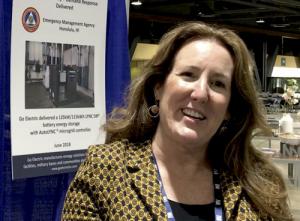Video: Go Electric, Electrification 2018

Go Electric hosted a booth at the Electric Power Research Institute’s Electrification 2018 International Conference & Exposition held in Long Beach, California August 20-23, 2018. With over 1,700 attendees, engaging speakers and panels, and a show floor chock full of the latest technology, PUF’s Steve Mitnick caught up with Go Electric’s president and CEO Lisa Laughner on the company’s many grid resiliency offerings.
Lisa Laughner: I'm Lisa Laughner, CEO of Go Electric, and we are at the EPRI Electrification Conference to talk about what Go Electric is doing in the microgrid world. We have a patented technology that helps make sure your facility lights always stay on, you stay operational during a grid outage, and we also integrate all your renewables to help your renewable energy be a part of your resiliency solution.
And it doesn't stop there. We also help utilities maintain grid stability because we can provide that same resiliency to the facility as well as to the utility.
Steve Mitnick: What's different about your offering?
Lisa Laughner: What's different about our offering is our technology includes a UPS, an uninterruptible power supply, for the facility and also for the utility. So, if you need to seamlessly go from grid tied to grid-islanded, which is very important for, say, hospitals, data centers, and other facilities with critical operations, they can't stand that blip in power. We do that as a part of our technology.
And also, if you are a utility with lots of PV and you don't want your PV invertors to turn off in a grid outage, we can also keep those operating safely within the microgrid.
Steve Mitnick: Are you making great progress?
Lisa Laughner: We are. We started with three people in 2011. We have now grown to twenty-seven with offices in three states, projects as far as Hawaii and New York, and as a startup we've closed just about ten million dollars in investor funding, so we're doing, I think, pretty good for a startup company.



